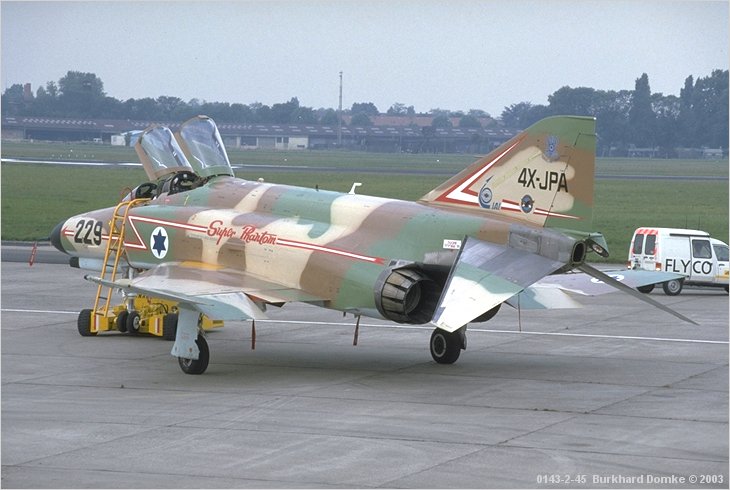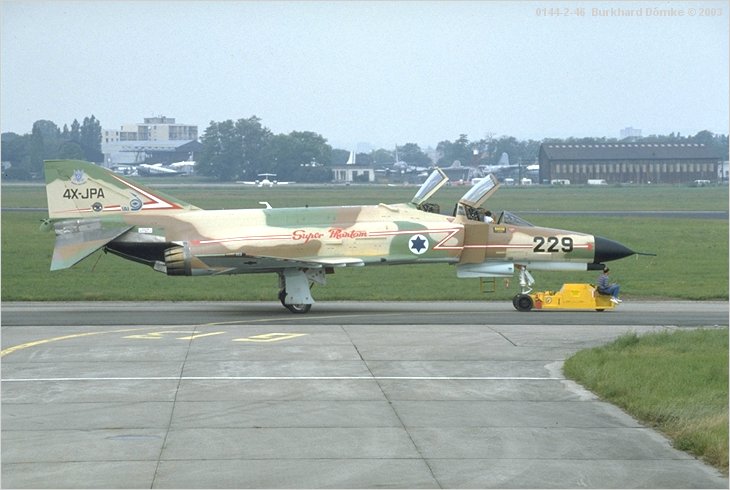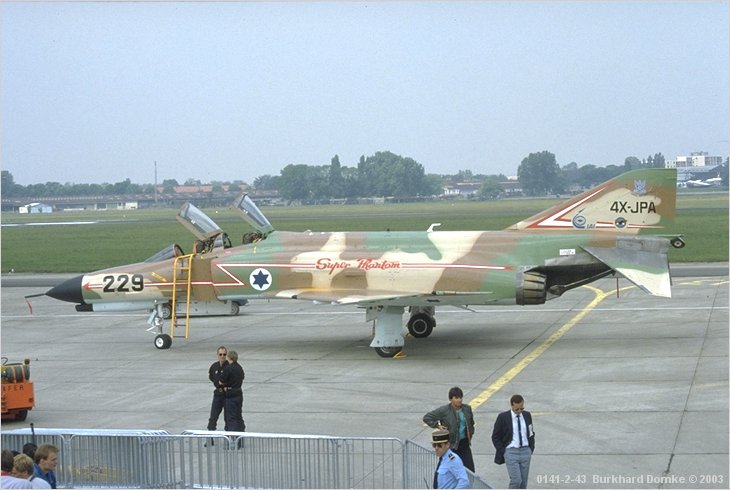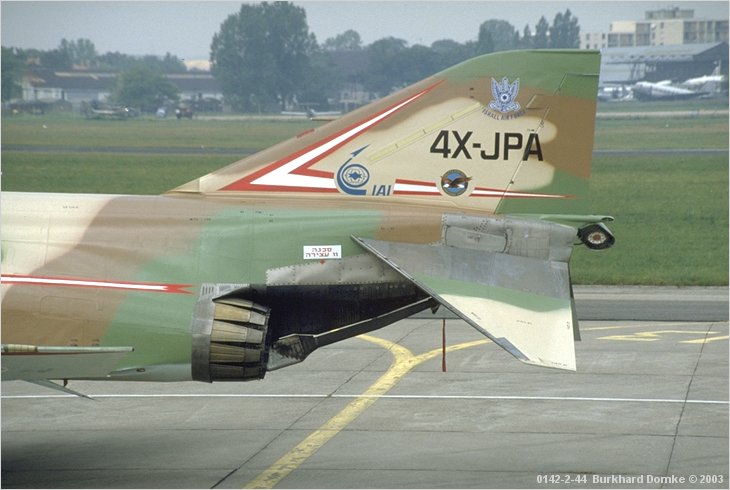Anthony Thornborough in USAF Phantoms of 1988.
"a proposal was made in the early 1980s to adapt the system to the F-4, which was assuming the Strategic Air Defense mission. If the proposal proved to be feasible, a total of about 180 F-4Ds would be retrofitted... F-4D 64-0945 was selected for the flight test which was conducted by the 119th FIG, North Dakota ANG, at Fargo. The flight test period began on June 29th 1985, and ended 32 sorties later the following October.
The IRSTS was successful in that it proved that the ‘off- the-shelf seeker heads could be installed and integrated with the F 4D radar system [for under $140,000 per aircraft - cheaper than a modern air-to-air missile round.
Also just in view is the F~15- type Hughes APG-63 pulse-doppler radar, which would offer the F-4D a true clutter-free, look-down capability with clear, combined IRSTS and radar target symbology on the cockpit ’scopes. If the IRSTS retrofit goes ahead, the sensor will be located under the nose to reduce the slightly higher cockpit noise generated by the blister, and to enhance the IRSTS’s FOV.
... on offer is a 1,100 US gallon Conformal Fuel Tank (CFT) which can be bolted on the F-4’s belly. This is proven technology. In 1970, after some four years of privately funded studies by BMAC, the USAF/USN awarded a joint-service development contract to Boeing to design and supply such a pallet. Flight trials commenced in August 1972 on an F-4B at China Lake, California. Before the test data had been fully processed the following summer, it was clear that the performance gains were remarkable.
Configured with full internal fuselage and CFT fuel (thereby deleting the requirement for the ‘draggy’ external tanks), the F-4B was rigged to carry a number of munitions in a low-drag conformal mode under the pallet; these weapons loads included up to twelve 5001b or 7501b bombs, of five different types. Compared to a comparatively crude TER/MER ejection rack-toting bomber, the CFT F-4B provided significant improvements - 75 per cent less drag, 43 per cent more range, an increased loiter capability and, very importantly, a safe higher-speed weapons separation capability, turning the F-4 into a true supersonic bomber. Normal TER/MER ‘iron’ bomb equipped Phantoms are limited to Mach 1, but the CFT F-4B performed safe weapons release at speeds ranging between Mach 1.25 at 10,000ft and Mach 1.8 at 30,000ft. Most remarkable of all was the test data that showed that even when weighed down with the bombs the CFT Phantom actually performed better than a ‘clean’ F-4! Flight-test crews at China Lake anticipated that they could perform SAM avoidance manoeuvres without having to jettison their external loads. With such positive results, it seems absurd that no CFTs were deployed on operational Phantoms, but there were some policy hiccups in the project. First, the USAF were anxious to replace their Phantoms with the undoubtedly higher performance F-15. Money was short, and TAC HQ’s initial plans were to withdraw most F-4s from front-line service by 1980. For the short lifetime expected for the CFT, the pay-off was considered too marginal. The second factor was that the CFT blocked off the F-4’s Sparrow missile wells, thereby confining the aircraft to guns and Sidewinder missiles for air combat. Pending the introduction of the sophisticated AIM-7F Sparrow, the F-4s were required to hold the air defence fort as the F-15s were suffering from some very complex interface problems with the Sparrow models then in service. By the time the F-15 achieved IOC with the AIM-7F the F-4 would be due for retirement, and the high cost of the pallets could not be justified. The possibility of extending the service life of the F-4 well into the 1990s and beyond as a pure strike or interceptor machine has now given much new impetus to the BMAC pallet concept. Furthermore, as an added bonus, Boeing has redesigned a slimmer CFT compatible with a great number of Weasel and recce stores, bombs, AGMs, LGBs and AIMs, including a full complement of Sparrow or AMRAAM missiles.
Within the USAF, where a potential upgrade market for up to 1,000 [out of 1400 then in service] Phantoms exists, the views remain split. Some within the Air Force see the upgrade as an opportunity to provide highly capable, modestly priced jets for use by the reservists into the early twenty-first century. Others are fiercely opposed, saying that the programme would eat deeply into the budgets of LANTIRN and similar systems: even if such projects are not affected, this lobby argues, sales of reworked surplus F-4s overseas would reduce sales of newer F-16s and other American fighters, subsequently causing USAF unit prices to escalate. Besides, they claim, the Phantom is simply too long in the tooth to justify a total refit.
The USAF stand is further complicated by another controversy. In recent moves, Congress mandated that the USAF evaluate the General Dynamics F-16 and Northrop F-20 in a competitive fly-off with a view to procuring some 270 of one type to replace all air defence-assigned F-4C/Ds by 1991. The F-16 was declared the winner in November 1986, and selected Block 15 aircraft will receive an air defence kit while undergoing scheduled PDM at Ogden, giving them Sparrow/AMRAAM capability. However, there are opponents: commanders, test pilots and weapons and tactics officers, all experienced men, have publicly stated that the F-16 is the ‘least desirable’ of all available options or, more bluntly, ‘the wrong choice for the strategic defence mission’, unable to engage cruise missiles and limited in air-to-air ordnance capacity. Given the realities of budget restraints, and the consequent lack of funds for F-15 Eagles for the job, many in this school firmly believe that the North Dakota ANG’s proposal for Hughes to refit 180 selected F-4Ds with IRSTS, the APG-63 (F-15) radar, and possibly a BMAC pallet for around $3.5 million a copy is the right choice. The lobby is gathering momentum. "






